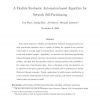100 search results - page 14 / 20 » Adding Autonomic Capabilities to Network Fault Management Sy... |
OPODIS
2010
13 years 5 months ago
2010
Abstract. Wireless Ad-hoc networks are distributed systems that often reside in error-prone environments. Self-stabilization lets the system recover autonomously from an arbitrary ...
IJDSN
2008
13 years 7 months ago
2008
This article proposes a flexible and distributed stochastic automaton-based network partitioning algorithm that is capable of finding the optimal k-way partition with respect to a...
MONET
2007
13 years 7 months ago
2007
With an increasingly mobile society and the worldwide deployment of mobile and wireless networks, the wireless infrastructure can support many current and emerging healthcare appli...
AP2PC
2003
Springer
14 years 21 days ago
2003
Springer
Peer-to-Peer (P2P) technologies promise to provide efficient distribution, sharing and management of resources, such as storage, processing, routing and other sundry service capabi...
CISIS
2010
IEEE
2010
IEEE
Computational Grid as an Appropriate Infrastructure for Ultra Large Scale Software Intensive Systems
14 years 2 months ago
—Ultra large scale (ULS) systems are future software intensive systems that have billions of lines of code, composed of heterogeneous, changing, inconsistent and independent elem...

